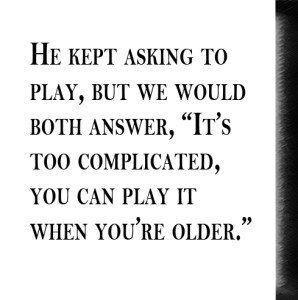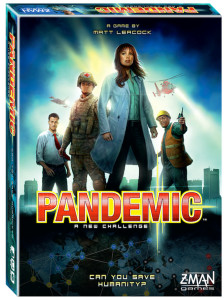An article by Thomas Kolar
There are two things you should know about my life in order to understand why my wife and I made a rules adaptation of Pandemic to play with my 3 year old son, Billy.
The first thing is that my wife is also a tabletop gamer. In fact, she has played more D & D than I have, which makes me a lucky man.
The second thing is that we both have backgrounds as teachers, which means Billy is an unlucky child. Our impulse as parents is to take anything he’s interested in as an educational opportunity. He’s enjoying watching Mulan? Let’s get out some picture books about China! Time for M&M’s? Let’s count them!
I got Pandemic for my birthday, and he loved taking it out and looking at the pieces. Who can blame him? He asked about how you play it, and I tried to explain the basic mechanics in a way he could understand– “the cubes are germs, and you go around and get the  germs away. Then you try to make medicine for the germs!” He kept asking to play, but we would both answer, “It’s too complicated, you can play it when you’re older.” He would insist it was not too complicated: “I can pick up the germs and find the medicine!” And this got my wife and me thinking–could we make a version he would understand? The game is about complex, painful decision-making way outside of his capability to comprehend, but it also involves matching colors and counting, which are not so outside of his capacity. So, after a couple days of tossing around ideas, we told him we were ready to try “Pandemic for kids.” He had watched us play, and was so, so excited at the chance to play a “grown-up game.” So here’s those rules, for your use if you’re interested.
germs away. Then you try to make medicine for the germs!” He kept asking to play, but we would both answer, “It’s too complicated, you can play it when you’re older.” He would insist it was not too complicated: “I can pick up the germs and find the medicine!” And this got my wife and me thinking–could we make a version he would understand? The game is about complex, painful decision-making way outside of his capability to comprehend, but it also involves matching colors and counting, which are not so outside of his capacity. So, after a couple days of tossing around ideas, we told him we were ready to try “Pandemic for kids.” He had watched us play, and was so, so excited at the chance to play a “grown-up game.” So here’s those rules, for your use if you’re interested.
Pedia-demic (as named by my wife).
Apologies if I misremembered any component part names. In all things, be happy to modify rules or speed things up to deal with diminishing little attention spans.
The basic goal is the same–find cures for all 4 diseases. However, now you find the cures by collecting 8 cubes of that color. The Epidemic Track is used as a counter for the “germ cubes” you need, with the Epidemic Counter covering up “0.” As you collect the cubes (more on how to do that in a moment,) you line them up on that track, which lets you practice counting and do some basic math: “We have four red germs! How many do we need to have 8 and get the medicine?” When you get 8 cubes, you put down the “medicine” vial for that color, clear those cubes, and ignore infection or player cards of that color.
You pick a piece/role. There is no difference in the roles, but if he gets older and is still interested in the game, we’ll make some modified role cards.
At the start of each player’s turn, draw one infection card and put germ cubes on that city. If you get an Epidemic card, it’s “double germs!” and you draw a second city. The number of cubes you infect is set by the Infection Rate marker, which you advance at the end of every turn in this version. This increases to 4 cubes after the fifth or sixth turn, which means that at that point it will be easy to get the 8 required cubes for each color and end the game. You can move it up at the end of each player’s turn, or at the end of everyone’s turns, depending on whether you want the game to slow down or speed up. In theory you lose if you run out of infection cards, but that’s not realistically going to happen. If our son starts getting bored with winning, we’ll come up with some new, more pressing fail conditions.
At the first turn, the players each draw 2 cards. Every other turn after the first, they draw one card at the start. If you’re not getting the right color to get the germs, go ahead and draw two cards at the beginning of every turn.
 You pick up germ cubes for the track by playing a card of the same color as the targeted disease/city, not one that’s exactly the same as the target city. Our son isn’t interested in actually moving his piece around the board to the infected cities, but if your kids are, go for it. It’s also a chance to sneak in some geography. “That’s Hong Kong! It’s a big city in China, which is where Mulan lived!” We *had* a rule planned for the Research Centers, which was that after the 8th germ cube, you spent a color card to build a “Hospital” in that city to make the medicine, but our son didn’t express any interest in them, so we’ve cut it for now.
You pick up germ cubes for the track by playing a card of the same color as the targeted disease/city, not one that’s exactly the same as the target city. Our son isn’t interested in actually moving his piece around the board to the infected cities, but if your kids are, go for it. It’s also a chance to sneak in some geography. “That’s Hong Kong! It’s a big city in China, which is where Mulan lived!” We *had* a rule planned for the Research Centers, which was that after the 8th germ cube, you spent a color card to build a “Hospital” in that city to make the medicine, but our son didn’t express any interest in them, so we’ve cut it for now.
Billy also came up with a tutorial rule! After the first game, he wanted to play with just the red germs. Then when we beat it, he asked to play with two colors, then three. Starting with one made it easier for him to understand the game and learn the rules. For the two or three-color rounds, we just used those color cubes for the adjacent city–so yellow cubes infected blue or yellow cities if we drew their cards.
We’ve had about 4 successful games out of about 8 plays. In other words, about half the time he’s actually had the patience or focus to finish the game, as opposed to just wanting to stack the germ cubes in shapes. Which is very exciting! He’s never sat through any game of Candyland or Hungry Hungry Caterpillar. I’m glad he likes it, and I’m hoping to modify some of our other games for us to play with Billy. I want him to learn following rules, and counting, and math, and geography, but more important than that, I want him to learn that games are something we do together, as a family. They’re part of our life. Because when the day comes when I’m asking him to spend time together, I want us to have games.






Thank you for this. Trying to adapt games for my 6 yo. Difficult! We played a simplified Lord of the Rings Confrontation (ignoring most text) but I’m stymied with most games. Trying to simplify Zooretto next.